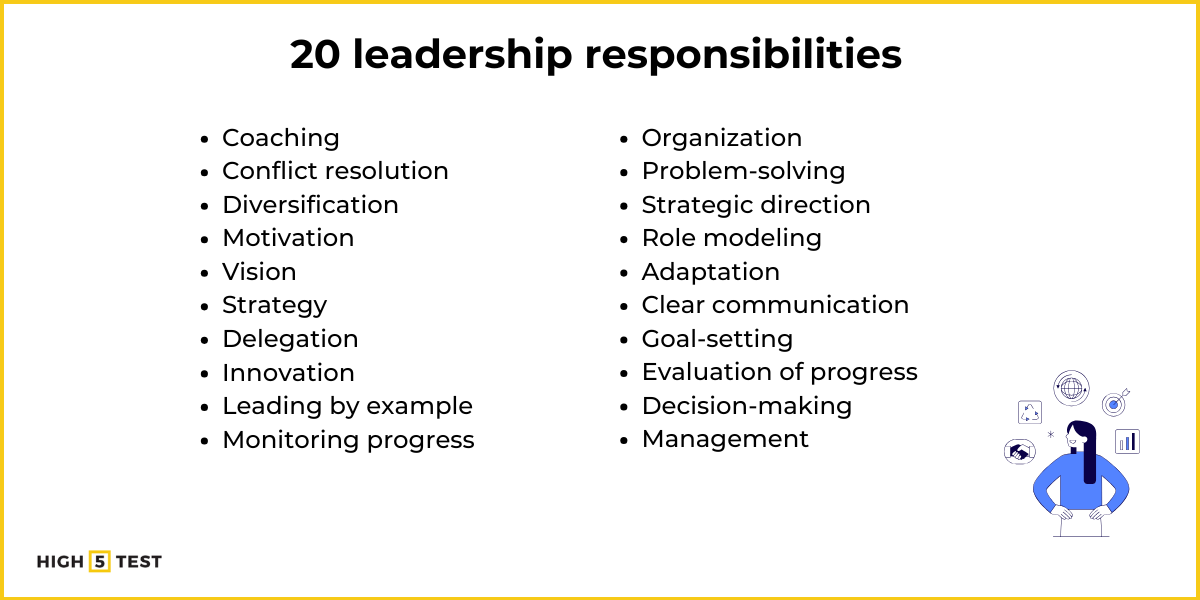Leaders need to motivate and inspire their teams, delegate tasks, and provide direction and guidance. While some individuals naturally exhibit leadership qualities, others may need to hone these skills over time. Wherever you stand, understanding your innate strengths is crucial for effective leadership. The HIGH5 strengths assessment can provide valuable insights into your natural talents, helping you leverage them as strong leaders. Thrive and inspire as a leader when you develop your unique strengths. In this article, we’ll explore what makes a great team leader. We’ll also provide some tips on how you can develop your leadership skills.
What does a leader do?
A leader guides and influences a group or organization toward achieving specific goals. Leaders make decisions, set direction, and motivate their team to perform at their best! Leaders often serve as role models and key decision-makers within a team or company.

What are leadership responsibilities?
Leadership and management responsibilities include:
- Coaching
- Conflict resolution
- Diversification
- Motivation
- Vision
- Strategy
- Delegation
- Innovation
- Leading by example
- Monitoring progress
- Organization
- Problem-solving
- Strategic direction
- Role modeling
- Adaptation
- Clear communication
- Goal-setting
- Evaluation of progress
- Decision-making
- Management

Coaching
Guide and develop your team members, offering support, feedback, and opportunities for growth. Coaching involves helping individuals improve their skills and achieve their professional goals.
Conflict resolution
Address and resolve conflicts within the team to maintain a harmonious and productive work environment. Effective conflict resolution requires empathy, patience, and the ability to mediate and find solutions.
Diversification
Foster diversity within your team, ensuring a mix of skills, perspectives, and backgrounds. A diverse team can drive innovation and better decision-making.
Motivation
Inspire and energize their team members to perform at their best. Motivation can be achieved through recognition, rewards, setting clear goals, and creating a positive work environment.
Vision
Articulate the organization’s vision and goals, ensuring the team understands the bigger picture. This helps align the team’s efforts with the company’s long-term objectives.
Strategy
Develop strategies to achieve organizational goals, considering both short-term and long-term perspectives. Strategic thinking involves analyzing the competitive landscape, setting priorities, and allocating resources effectively.
Delegation
Assign tasks and responsibilities to team members based on their strengths and skills. Effective delegation maximizes productivity and allows leaders to focus on higher-level strategic tasks.
Innovation
Encourage and facilitate innovation within the team. Foster a culture that embraces new ideas and creative problem-solving; stay adaptable and open to change.
Leading by example
Set the standard for behavior and performance through their actions. By modeling the values and work ethic they expect from their team, they build credibility and trust.
Monitor progress
Regularly check in on the progress of tasks and projects, ensuring that goals are being met on time and within scope. Monitoring progress helps identify potential issues early and keeps the team on track.
Organization
Keeping your team organized, set clear priorities, and manage your time and resources efficiently. Good organizational skills paired with team-building exercises help streamline processes and improve overall team productivity [1].
Problem-solving
Leaders tackle challenges and obstacles that arise, finding effective solutions to keep the team moving forward. Strong problem-solving skills are essential for overcoming difficulties and maintaining progress toward goals.
Provide adequate resources
Ensure that their team has the necessary tools, information, and support to complete their tasks effectively. This includes securing budgets, equipment, training, and other resources.
Providing strategic direction
Set strategic direction for the team or organization, aligning efforts with broader goals. This involves making key decisions that shape the future trajectory of the team.
Role model
Leaders serve as role models for their team, demonstrating the behaviors, attitudes, and values that they expect from others. Being a role model builds trust and sets a positive tone for the team.
Adaptor
Serve as role models for their team, demonstrating the behaviors, attitudes, and values that they expect from others. Being a role model builds trust and sets a positive tone for the team.
Adaptor
Respond to changing circumstances, adapt, and pivot strategies as needed. Flexibility is key to managing uncertainty and guiding the team through complex transitions.
Communicating clearly
Convey messages clearly and concisely, ensuring that all team members understand their instructions, feedback, and expectations. Clear communication is essential for effective teamwork, as 27% of a sample of HR managers and employees have quit in the past due to a lack of communication [2].
Setting goals
Set and articulate the team’s objectives and ensure that each member understands their role in achieving these goals. Clear goals help your team members to align efforts and maintain focus.
Evaluation of team progress
Assess the team’s progress toward its goals, identifying areas of success and opportunities for improvement. Evaluation helps in making informed decisions and adjustments to strategies.
Liaison between workers and management
Act as intermediaries between their team and higher management, ensuring that communication flows smoothly in both directions. Represent the team’s interests while also conveying management’s expectations.
Decision-making
Make informed decisions that affect the team and the organization. Good decision-making involves analyzing data, considering risks, and weighing options to choose the best course of action.
Management
Manage the day-to-day operations of the team, ensuring that tasks are completed efficiently and that the team functions smoothly. This includes overseeing schedules, budgets, and workflows. The HIGH5 strengths assessment can be an invaluable tool in this journey, helping aspiring leaders identify their natural talents and how to apply them to these key responsibilities. For instance, if your top strength is ‘Strategist,’ you might excel in developing team operations, while someone with ‘Empathy’ as a top strength could be particularly effective in ensuring team welfare.
If you’re interested in becoming a team leader, consider taking the HIGH5 assessment as a first step, followed by pursuing leadership education that aligns with your strengths profile. This strengths-based approach to leadership development can accelerate your growth and effectiveness as a team leader.
What is the difference between a manager and a team leader?
The main difference between a manager and a team leader is that a manager oversees a group of employees, and is responsible for planning, budgeting, and supervising the overall operations of a company or department. A team leader, in contrast, actively leads a team of employees. What exactly does leading mean?
Leading calls for guiding and motivating team members to achieve common goals. While both managers and team leaders are important roles in any organization, they have different responsibilities. It is important to understand the difference between these two positions so you can decide which one is right for you.
Pro Tip From HIGH5
Leverage your team’s diverse strengths to fulfill leadership responsibilities more effectively. Use the HIGH5 strengths assessment to identify each team member’s unique talents, then align tasks and roles accordingly. This approach not only enhances individual performance but also creates a more cohesive and productive team environment.
Types of leadership roles
The 5 leadership roles are:
- Manager
- Mentor
- Trainer
- Organizer
- Coach
Manager
A manager is responsible for overseeing a team or department, ensuring that tasks are completed efficiently and objectives are met. They manage resources, set goals, and monitor progress, often making key decisions that impact the team’s success. Managers also play a crucial role in performance evaluations and maintaining team morale.
Mentor
A mentor provides guidance, advice, and support to less experienced team members, helping them navigate their careers and develop their skills. Mentors share their knowledge and experience, offering insights that help mentees grow both personally and professionally. This role involves building a trusting relationship and offering continuous encouragement.
Trainer
A trainer is focused on developing the skills and knowledge of team members through structured learning programs. They design and deliver training sessions, workshops, or one-on-one coaching to ensure that team members are well-equipped to perform their roles effectively. Trainers also assess the progress of trainees and adjust the training content as needed.
Organizer
An organizer is responsible for coordinating tasks, resources, and schedules to ensure that projects are completed on time and within scope. They set priorities, delegate tasks, and manage timelines for their team. This role requires strong attention to detail and the ability to juggle multiple responsibilities simultaneously.
Coach
A coach helps team members enhance their performance by providing feedback, setting goals, and encouraging continuous improvement. Coaches focus on the development of individual strengths and work closely with team members to overcome challenges. This role involves motivating the team and fostering a culture of learning and growth.
How do you become a responsible leader?
Develop self-awareness
Start by understanding your strengths, weaknesses, values, and motivations. Self-awareness helps you make informed decisions and act with integrity, which are essential qualities of a responsible leader.
Lead by example
Model the behavior, work ethic, and attitude you expect from your team. Demonstrating consistency in your actions builds trust and sets a standard for others to follow.
Communicate clearly and honestly
Maintain open lines of communication with your team, sharing information transparently and listening actively. Clear communication fosters a culture of trust and respect.
Take accountability
Accept responsibility for your decisions and their outcomes, whether positive or negative. Being accountable shows your team that you are reliable and committed to your role.
Empower your team
Delegate tasks effectively and trust your team members to carry them out. Empowering others encourages their growth and development, and creates a more collaborative work environment.
Continuously learn and improve
Stay open to feedback and be willing to adapt and grow as a leader. Continuous learning ensures that you remain effective and responsive to the needs of your team and organization.
Prioritize ethical decision-making
Make decisions that align with ethical standards and consider the well-being of your team, stakeholders, and the broader community. Responsible leaders act with integrity, even when faced with difficult choices.
Foster inclusivity and diversity
Create an environment where all team members feel valued and included, regardless of their background or perspective. A responsible leader recognizes the strength that diversity brings to the team.
Provide support and resources
Ensure your team has the tools, resources, and support they need to succeed. Being attentive to their needs and removing obstacles helps them achieve their best performance.
Reflect and adapt
Regularly reflect on your leadership practices and be willing to make changes as needed. Responsible leadership is about continuous improvement and being adaptable in the face of new challenges. An adaptive leadership approach can increase self-efficacy (the belief in taking action toward goals) in your team [3].
Why do we need team leaders in organizations?
Your role as a team leader is crucial for the success of any organization. As a leader, you help inspire and motivate teams to achieve common goals and help build an effective working environment where everyone can thrive and grow. There are many reasons why we need team leaders in organizations. Firstly, team leaders help to set the direction for the team and ensure that everyone is working towards the same goal. Team leaders provide support and guidance to team members, helping them to overcome challenges and stay on track. As a leader, you act as a link between management and the team and ensure communication is clear and concise.
The impact of a good team leader can reach far, especially with a strengths-based approach. By utilizing tools like the HIGH5 strengths assessment, leaders can identify and harness their team members’ unique talents. Create a well-led team that is not only more productive, efficient, and effective but also more engaged and fulfilled. When team members are aligned with their natural strengths, they are better equipped to achieve their goals and contribute to organizational success. A team led by a strong leader will be more cohesive and motivated and will have higher morale.

10 benefits of great leadership
A good team leader…
- Provides guidance and support to team members, and helps them to overcome challenges to achieve their goals.
- Helps create a positive and motivating team environment, where team members feel valued.
- Effectively communicates with all members of the team, ensuring that everyone is on the same page and working towards the same goal.
- Identify each member’s strengths and weaknesses to maximize the team’s potential.
- Resolves conflicts within the team quickly and effectively, ensuring focus on the task at hand.
- Sets clear goals and deadlines for their team.
- Provides regular feedback to team members.
- Encourages and motivates team members, and provides them with the support they need to succeed.
- Is a role model.
- Creates a positive and cohesive team.
If you are looking to promote someone to a leadership role, or are considering taking the responsibility yourself, then take the first step in developing the necessary skills and attributes to become a successful team leader.
Pro Tip From HIGH5
Use the HIGH5 strengths assessment to create a strengths map of your team. This visual representation can help you identify complementary strengths, potential blind spots, and opportunities for collaboration. Regularly refer to this map when assigning tasks, forming project teams, or addressing challenges to maximize your team’s potential and foster a culture of appreciation for diverse talents.
Leadership responsibilities FAQ
What is the most important responsibility of a leader?
The most important responsibility of a leader is to ensure that the team they lead is effective and efficient. Set clear goals and objectives, and provide the necessary support and resources to help the team achieve these goals. Leaders also need to be able to motivate and inspire their team members and create a positive working environment.
How can I be a good team leader?
Many qualities make a good team leader, but some of the most important include being able to communicate effectively, being organized and efficient, being able to motivate and inspire others, and having a positive attitude [4]. Good leaders will also be able to build strong relationships with their team members and provide them with the support they need to be successful.
What are the five key functions of leadership?
The five key functions of leadership are setting goals, organizing work, motivating the team, providing guidance, and monitoring progress. These functions ensure that a team is aligned, productive, and moving towards its objectives.
References:
- Kozlowski, S. W. J., & Ilgen, D. R. (2006). Enhancing the Effectiveness of Work Groups and Teams. Psychological Science in the Public Interest, 7(3), 77-124. https://doi.org/10.1111/j.1529-1006.2006.00030.x.
- “Quick quitting”: Why are your employees leaving so soon? (n.d.). Www.hcamag.com. https://www.hcamag.com/us/specialization/employee-engagement/quick-quitting-why-are-your-employees-leaving-so-soon/441148.
- Chughtai, M. S., Syed, F., Naseer, S., & Chinchilla, N. (2023). Role of adaptive leadership in learning organizations to boost organizational innovations with change self-efficacy. Current psychology (New Brunswick, N.J.), 1–20. Advance online publication. https://doi.org/10.1007/s12144-023-04669-z.
- IESE Business School. (2024, June 13). Five Secrets To Positive Leadership. Forbes. https://www.forbes.com/sites/iese/2024/06/12/five-secrets-to-positive-leadership.
- Loh, K. K., & Kanai, R. (2014). Higher media multi-tasking activity is associated with smaller gray-matter density in the anterior cingulate cortex. PloS one, 9(9), e106698. https://doi.org/10.1371/journal.pone.0106698.






